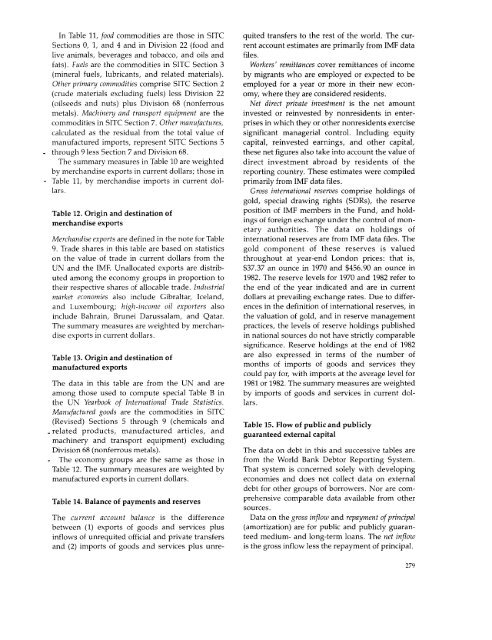World Development Report 1984
World Development Report 1984
World Development Report 1984
You also want an ePaper? Increase the reach of your titles
YUMPU automatically turns print PDFs into web optimized ePapers that Google loves.
In Table 11, food commodities are those in SITC quited transfers to the rest of the world. The cur-<br />
Sections 0, 1, and 4 and in Division 22 (food and rent account estimates are primarily from IMF data<br />
live animals, beverages and tobacco, and oils and files.<br />
fats). Fuels are the commodities in SITC Section 3 Workers' remittances cover remittances of income<br />
(mineral fuels, lubricants, and related materials). by migrants who are employed or expected to be<br />
Otiher primary commodities comprise SITC Section 2 employed for a year or more in their new econ-<br />
(crude materials excluding fuels) less Division 22 omy, where they are considered residents.<br />
(oilseeds and nuts) plus Division 68 (nonferrous Net direct private investment is the net amount<br />
metals). Machinery and transport equipment are the invested or reinvested by nonresidents in entercommodities<br />
in SITC Section 7. Other manufactures, prises in which they or other nonresidents exercise<br />
calculated as the residual from the total value of significant managerial control. Including equity<br />
manufactured imports, represent SITC Sections 5 capital, reinvested earnings, and other capital,<br />
through 9 less Section 7 and Division 68. these net figures also take into account the value of<br />
The summary measures in Table 10 are weighted direct investment abroad by residents of the<br />
by merchandise exports in current dollars; those in reporting country. These estimates were compiled<br />
- Table 11, by merchandise imports in current dol- primarily from IMF data files.<br />
lars. Gross international reserves comprise holdings of<br />
gold, special drawing rights (SDRs), the reserve<br />
Table 12. Origin and destination of position of IMF members in the Fund, and holdmerchandise<br />
exports ings of foreign exchange under the control of monetary<br />
authorities. The data on holdings of<br />
Merchandise exports are defined in the note for Table international reserves are from IMF data files. The<br />
9. Trade shares in this table are based on statistics gold component of these reserves is valued<br />
on the value of trade in current dollars from the throughout at year-end London prices: that is,<br />
UN and the IMF. Unallocated exports are distrib- $37.37 an ounce in 1970 and $456.90 an ounce in<br />
uted among the economy groups in proportion to 1982. The reserve levels for 1970 and 1982 refer to<br />
their respective shares of allocable trade. Industrial the end of the year indicated and are in current<br />
market economies also include Gibraltar, Iceland, dollars at prevailing exchange rates. Due to differand<br />
Luxembourg; high-income oil exporters also ences in the definition of international reserves, in<br />
include Bahrain, Brunei Darussalam, and Qatar. the valuation of gold, and in reserve management<br />
The summary measures are weighted by merchan- practices, the levels of reserve holdings published<br />
dise exports in current dollars. in national sources do not have strictly comparable<br />
significance. Reserve holdings at the end of 1982<br />
Table 13. Origin and destination of are also expressed in terms of the number of<br />
manufactured exports months of imports of goods and services they<br />
could pay for, with imports at the average level for<br />
The data in this table are from the UN and are 1981 or 1982. The summary measures are weighted<br />
among those used to compute special Table B in by imports of goods and services in current dolthe<br />
UN Yearbook of International Trade Statistics. lars.<br />
Manufactured goods are the commodities in SITC<br />
(Revised) Sections 5 through 9 (chemicals and Table 15. Flow of public and publicly<br />
related products, manufactured articles, and<br />
machinery and transport equipment) excluding<br />
Division 68 (nonferrous metals). The data on debt in this and successive tables are<br />
The economy groups are the same as those in from the <strong>World</strong> Bank Debtor <strong>Report</strong>ing System.<br />
Table 12. The summary measures are weighted by That system is concerned solely with developing<br />
manufactured exports in current dollars. economies and does not collect data on external<br />
debt for other groups of borrowers. Nor are com-<br />
Table 14. Balance of payments and reserves prehensive comparable data available from other<br />
sources.<br />
The current account balance is the difference Data on the gross inflow and repayment of principal<br />
between (1) exports of goods and services plus (amortization) are for public and publicly guaraninflows<br />
of unrequited official and private transfers teed medium- and long-term loans. The net inflow<br />
and (2) imports of goods and services plus unre- is the gross inflow less the repayment of principal.<br />
279









